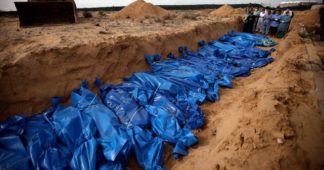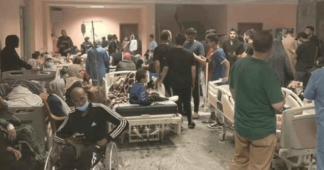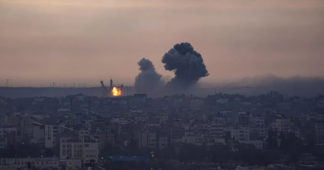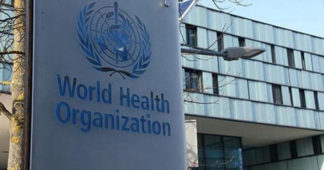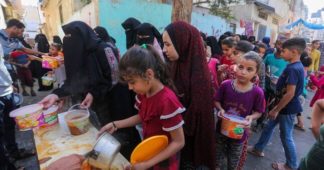Disease is poised to become an even deadlier second front in Israel’s assault on the besieged Strip.
By Maya Rosen
January 5, 2024
On November 28th, Margaret Harris, a spokesperson for the World Health Organization (WHO), warned that the catastrophe unfolding in Gaza was likely to become even worse. “Everybody everywhere [in Gaza] has dire health needs now because they’re starving, because they lack clean water, and [they’re] crowded together,” she said at a UN briefing in Geneva, before concluding with an ominous pronouncement: “Eventually, we will see more people dying from disease than we are even seeing from the bombardment.”
Israel’s ongoing war on Gaza has already killed nearly 23,000 people, with 7,000 others buried under rubble and 55,000 more injured. But what Harris was pointing to was a second, quieter war front that now stands to escalate dramatically. Since October 7th, Israel has severely reduced the entry of food, water, and fuel into Gaza, successfully creating what global health expert Yara Asi described as “a dire human-made humanitarian catastrophe” characterized by mass hunger, thirst, homelessness, and lack of medical services. As months pass without any meaningful relief, these conditions have produced “the perfect storm for disease,” in the words of United Nations Children’s Fund spokesperson James Elder. On January 2nd, the WHO announced that there are currently 424,639 cases of infectious diseases in Gaza. Since such official counts only represent those who were able to make it to a clinic or hospital, experts assume that the true rates are much higher. A half million infectious disease cases would still have overwhelmed Gaza’s healthcare system before October 7th, though many would have been treatable with food, water, and medical care. But today, amid an ongoing assault that has destroyed 27 of Gaza’s 36 hospitals, as well as the very foundations of the enclave’s public health—in the form of food, water, and shelter—epidemics are likely to mean mass death. “You don’t need overt bloodshed to cause significant violence that ends people’s lives,” Asi told Jewish Currents. “Many people will die unnecessary deaths due to deprivation.”
This concern has a firm historical basis: In most wars, including in Iraq, the Democratic Republic of the Congo, Yemen, and Darfur, far more people die of disease and starvation than through direct military assault. Indeed, according to public health scholar Barry Levy, indirect health-related deaths—which are seldom discussed when reporting the death toll of a war—can outnumber direct deaths by more than 15 to 1. In Gaza, such deaths are likely to keep increasing even if there is a ceasefire. Public health scholar Devi Sridhar recently estimated that, barring a dramatic shift which includes a resuscitation of the health system, half a million people—a quarter of Gaza’s population—could die from preventable health causes in the coming year.
In Israel, these grim warnings have not initiated any change of course. In fact, a vocal minority on the Israeli right has even lauded the spread of disease and starvation as a way of weakening Hamas. In October, Likud lawmaker Tally Gotliv argued in front of the Knesset that “hunger and thirst among the Gazan population” would help Israel’s war efforts, enabling the recruitment of desperate collaborators for intelligence purposes. Retired Israeli general Giora Eiland, who was formerly head of the Israeli National Security Council and is now an official wartime advisor to Defense Minister Yoav Gallant, has likewise asserted that Israel “must not be deterred” by the international community’s warnings about a humanitarian disaster in Gaza because “severe epidemics in the southern Strip will hasten our victory.” This position has not yet found purchase as an official war tactic: Prime Minister Benjamin Netanyahu has expressed opposition to it, and it has faced especially harsh criticism from Israeli public health experts. But analysts say Israel’s current policies are nevertheless consistent with the use of disease as a weapon. “When you cluster people and keep them away from medical care and water . . . it doesn’t take an epidemiology degree to know what’s going to happen,” Asi told Jewish Currents, adding that even though Israel is not intentionally introducing disease into Gaza, “if you wanted to [spread disease], you would do exactly what Israel is doing.”
The current health emergency in Gaza builds on the ruinous effects of years of Israeli restrictions on the Strip’s health system. As Asi told the Foundation for Middle East Peace on November 14th, “we’ve heard increasingly . . . that Gaza’s health system has collapsed. But in reality, Gaza’s health system has been on the verge of collapse essentially for 16 years.” Over that time, Israel has kept Gaza under a tightly controlled blockade, restricting access not only to medical equipment and medications, but also to food and water. Documents show that at one point, Israel even calculated the minimum caloric intake needed for survival; these restrictions have rendered 63% of Gaza’s population food insecure and left 30,000 children under the age of five severely malnourished. Similarly, 96% of Gaza’s water was already unsuitable for drinking before October 7th, causing a quarter of the enclave’s illnesses. As of 2018, waterborne illnesses were the leading cause of death for children in Gaza.
Israel’s newly intensified siege is exacerbating these vulnerabilities. In recent weeks, between 100 and 120 aid trucks have been entering Gaza each day, an 80% decrease from the pre-October 7th number. This chokehold on humanitarian supplies has led to calamitous shortages of basic necessities. For instance, according to the independent Famine Review Committee, 80% of the Palestinians in Gaza have reached the two most extreme levels of its food insecurity classification system—“emergency” and “catastrophe”—with half of the population at risk of starvation. Water shortages are also rampant in Gaza, and with the lack of fuel severely curtailing wastewater treatment and solid waste management, clean drinking water is impossible to find. As a result, people are drinking and cooking with unclean water, some digging wells to access water contaminated by sewage and solid waste build up, and others resorting to drinking seawater, where over 100,000 cubic meters of waste is discharged daily.
This growing sanitation crisis is compounded by constant Israeli bombardment, which has released toxic substances into the air and resulted in high numbers of unburied dead bodies in the streets and under rubble. Bombings and forced evacuations have also caused massive overcrowding. Since October 7th, Israel has displaced 90% of Gazans from their homes, pushing them into smaller and smaller areas and creating breeding grounds for disease. As of January 1st, about 1.4 million of the Strip’s 1.9 million displaced Palestinians were sheltering at United Nations Relief Works Agency (UNRWA) schools, sharing one toilet to every 486 people. (At least one UNRWA school has already reported a Hepatitis A outbreak.) In such close quarters, sick Gazans are unable to follow quarantine orders, leading to what WHO head Tedros Adhanom Ghebreyesus described as “the ideal conditions for disease to spread.”
Experts say that this unprecedented situation could lead to the emergence of deadly and highly contagious diseases not currently found in Gaza, such as measles and cholera, as well as typhoid and polio. The appearance of such illnesses at this moment could be devastating; cholera, for example, can usually be successfully treated, but in the absence of clean water and sanitation, the WHO notes that it “can kill within hours.” However, as Omar, an Israel-based Palestinian doctor who used a pseudonym due to fear of reprisal, told Jewish Currents, the danger isn’t limited to “exceptional diseases” since “even normal diseases—viral diarrhea, influenza, or lung infections—will be much more deadly in these circumstances.” Diarrhea is already the leading cause of death for children under five globally, killing 1,300 young children each day—and as of January 2nd, there were 136,400 cases of diarrhea reported in Gaza, about half of which were in children under five. To make matters worse, the war has disrupted vaccine schedules for children, who are now vulnerable to infectious diseases that they could have been inoculated against.
Public health experts, including in Israel, say Gaza’s health disaster could also reverberate back in Israel. In 2018, Shira Efron, a co-author of a report on the enclave’s water and sewage crisis, warned that waterborne diseases will not “stay on the other side of the fence.” Israeli officials themselves have noted the danger of water pollution from Gaza; indeed, sewage from the Strip has already spread illness and polluted beaches in Israel, in addition to forcing the closure of a desalination plant in Ashkelon. Such concerns have come to the fore again since the start of the recent war on Gaza. Already, Israeli soldiers are facing drug-resistant infections from bacteria in Gaza. An Israeli soldier recently died from a fungal infection, likely contracted due to sewage; the army also reported an outbreak of gastrointestinal illnesses, with some cases involving shigella—a bacteria that causes dysentery. Experts say soldiers are likely to bring such diseases into Israel in the coming weeks. As Nadav Davidovitch told Mako, “at the end of the day, we endanger ourselves when we don’t take into account the humanitarian side of civilians in Gaza.” Israeli public health experts have become particularly vocal in response to Eiland’s advocacy for the spread of disease, writing in a Haaretz op-ed that pandemics “do not know borders” and that diseases in Gaza will “spread without disruption and lead to sustained outbreaks among the civilian population” in Israel as well.
But not even the possibility of negative health consequences for Israelis has changed Israel’s instrumental approach to health in Gaza. Instead, the Israeli government has continued to treat disease merely as a tactical problem—one that needs to be managed to keep the war going. Indeed, on November 17th, an unnamed government source explained Israel’s decision to let limited amounts of fuel into Gaza as “minimal support for sewage, sanitation and water systems in order to prevent the outbreak of epidemics,” which could harm the war effort. Benny Gantz, a member of Israel’s current war cabinet, was likewise quick to note that letting in fuel “is not a question of changing strategy, but of providing a specific response that serves the continued fighting of the IDF.” Historically, disease has sometimes proven militarily decisive: Hitler’s army lost to British forces in North Africa in part because of sickness; smallpox led to the defeat of George Washington’s army in the Battle of Quebec; Napoleon’s army was defeated in Russia because of typhus. It is these military outcomes Israel seems most keen to prevent, with Netanyahu even explaining that preventing soldiers from getting sick was important because “any breakdown, from disease to water contamination, could halt the fighting.” These statements, the Israeli human rights group B’Tselem noted, are “astounding in their honesty: The Prime Minister and the Defense Minister admit, in front of cameras, that Israel is deliberately manufacturing a humanitarian crisis in the Gaza Strip. If Israel wills it, the crisis will be solved. If it does not, it will continue.”
There is no end in sight to the humanitarian cataclysm Israel has manufactured in Gaza—and increasingly, no way to fully apprehend its true toll. It is already impossible to assess the scale of indirect war-related deaths in Gaza. There are no statistics on the number of children who have already died of hunger, or the number of people dying because they can’t get dialysis or chemotherapy, or obtain their high blood pressure medication or insulin. Nor can we fully know how many are dying from the flu or diarrhea; dying because the hospitals are beyond capacity; or dying from infected wounds because of a lack of sanitation or antibiotics.
“The spectacle of bombing or tanks or even militants with GoPros—this is what we’re used to seeing as war,” Asi told Jewish Currents. But as Israel’s assault on Gaza illustrates, war makes life impossible in myriad other ways. Indeed, as Omar, the Palestinian doctor, noted, the spread of disease has long been central to warfare, like in the wars waged on Indigenous people in the United States and Canada. In such situations, he explained, “you kill a little bit, you do small massacres, but then if you crowd people together, diseases will do the rest. If you make sure they don’t have enough nutrition and take all of their food resources, diseases will kill them.” Public health experts have noted that Israel’s decision to create unlivable conditions in Gaza falls under the definition of genocide, which includes not just direct military violence but also “deliberately inflicting on the group conditions of life calculated to bring about its physical destruction.”
Every public health expert with whom I spoke agreed that a ceasefire is the first step towards addressing the health crisis in Gaza, “so that the hospitals will go back to functioning, so that aid—food, water, sanitary items, medicine—can reach everyone,” as Aseel Aburass from Physicians for Human Rights-Israel told Jewish Currents. But, as Asi noted, a ceasefire would only address the most explicit forms of violence, and the indirect toll of the war is likely to keep growing even if the bombs stop falling. “We have now reached the point where a ceasefire in one minute would not end the suffering of many for weeks, if not months,” Asi said. Fighting infectious disease, public health experts agree, requires allowing in food, medicine, and vaccines; building houses to shelter Gaza’s nearly two million displaced people; and investing in infrastructure—water treatment, sewage systems, and power grids.
But all this requires the political will to save lives in Gaza—something Israel and its international allies sorely lack. “If the world is able to tolerate this amount of Palestinian death by direct bombardment, it will be much more able to tolerate future reports of how many Palestians died from diseases,” Omar told Jewish Currents. “If you can burn people with phosphorus bombs, then of course you can crowd them together and let diseases do the rest. Who will cry now? What is a red line?”
Also read: Famine in Gaza ‘turning children into skeletons’: Reports
We remind our readers that publication of articles on our site does not mean that we agree with what is written. Our policy is to publish anything which we consider of interest, so as to assist our readers in forming their opinions. Sometimes we even publish articles with which we totally disagree, since we believe it is important for our readers to be informed on as wide a spectrum of views as possible.

